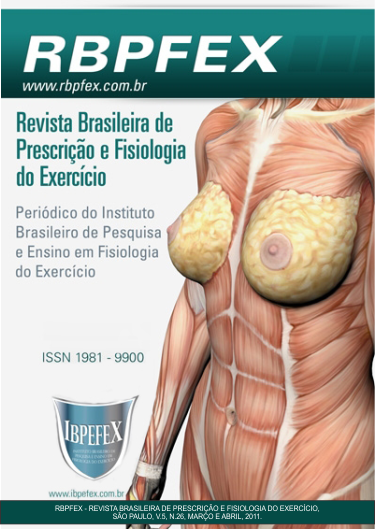Effect sharp hipotensor in a session of training for superior and other members for inferior members: a study of case
Abstract
Objective: This study’s objective is to examine the blood pressure response after a session of resisted training for superior members and another one for inferior members in a hypertensive individual with his/her hypertension controlled through medication. Materials and methods: a white skinned, sedentary, fifty-year-old woman, weighing 70,4 kilograms, and 1m 71 cm height. The study was performed in two days with 48 hours intervals between superior and inferior members sessions, with BP measurement before and immediately after the training, and every 5 minutes, during 60 minutes. Results: The study has identified that systolic (SBP), and diastolic blood pressure (DBP) remained with lower values than the ones verified before the training, except in the 45 and 55 minutes after the superior members training, in which the SBP and the DBP had a decrease if compared to the values measured at rest. Discussion: After the end of a training session the blood pressure can have a decrease lower than the values checked before the training, what features the post-exercise hypotension (PEH). Thus, the bigger magnitude andthe duration of the (PEH) more efficient the non-pharmacological strategy for the reduction of the BP at rest. Conclusion: It was observed that BP values are lower than the ones measured at rest; however, in the inferior members the decrease is larger, probably because of the quantity of musculature involved.
References
-Cunha, G.A.; Rios, A.C.S.; Moreno, J.R.; Braga, P.L.; Campbell, C.S.G.; Simões, H.G.; Denadai, M.L.D.R. Hipotensão pós-exercício em hipertensos submetidos ao exercício aeróbio de intensidades variadas e exercício de intensidade constante. Revista Brasileira Medicina do Esporte. Vol. 12. Num. 6. 2006. p. 313-317.
-Forjaz, C.L.M.; Cardoso Júnior, C.G.; Araújo, E.A.; Costa, L.A.R.; Teixeira, L.; Gomides, R.S. Exercício Físico e Hipertensão Arterial: riscos e benefícios. Revista Hipertensão. 2006. Vol. 9. Num. 3. 2006. p. 104-112.
-Laterza, M.C.; Rondon, M.U.P.B.; Negrão C.E. Efeito Anti-hipertensivo do exercício. Revista Brasileira de Hipertensão. Vol. 14. Num. 2. 2007. p. 104-111.
-Legramante, J.M.; Galante, A.; Massaro, M.; Attanasio, A.; Raimondi, G.; Pigozzi F. Hemodynamic and autonomic correlates of postexercise hypotension in patients with mild hypertension. American Heart Association. Vol. 28. Núm. 4. 2002. p. 1037-1043.
-Lisboa, G.; Abreu, D.G.; Cordeiro, L.S.; Knifis, F. Verificação das alterações provocadas pelo exercício contra resistência no indivíduo hipertenso. Revista de Educação Física. Num. 137. 2007. p. 18-25.
-McCartney, N.; McKelvie, R.S.; Martin, J.; MacDougall, J.D.Weight-training-induced attenuation of the circulatory response of older males to weight lifting. Journal of Applied. Vol. 74. Num. 3. 1993. p. 1056-1060.
-MacDougall, J.D.; Tuxen, D; Sale, D.G.; Moroz, J.R.; Sutton, J.R. Arterial blood pressure response to heavy resistance exercise.Journal of Applied Physiology. Vol. 58. Núm. 3. 1985. p. 785-790.
-Mediano, M.F.F.; Paravidino, V.; Simão, R.; Pontes, F.L.; Polito, M.D. Comportamento subagudo da pressão arterial após o treinamento de força em hipertensos controlados. Revista Brasileira de Medicina do Esporte. Vol. 11. Num. 6. 2005. p. 337-340.
-Mitchell, J.H.; Schibye, B.; Payne, F.C.; Saltin, B. Response of arterial blood pressure to static exercise in relation to muscle mass, force development, and electromyographic activity. Pubmed. Vol. 48. 1981. p. 170-175.
-Monteiro, M.F.; Sobral Filho, D.C. Exercício Físico e Controle da Pressão Arterial. Revista Brasileira Medicina do Esporte. Vol. 10. Num. 6. 2004. p. 513-516.
-Pierin, A.M.G. Hipertensão Arterial: Uma proposta para o cuidar. Barueri, SP: Manole, 2004. Cap. 11. p. 185-204.
-Pierin, A.M.G. Hipertensão Arterial: Uma proposta para o cuidar. Barueri, SP: Manole, 2004. Cap. Cap. 18. p. 313-333.
-Polito, M.D.; Farinatti, P.T.V. Comportamento da Pressão Arterial após exercícios contra-resistência: uma visão sistemática sobre variáveis determinantes e possíveis mecanismos. Revista Brasileira Medicina do Esporte. Vol. 12. Núm. 6. 2006. p. 386-392.
-Rondon, M.U.P.B.; Alves, M.J.N.N.; Braga, A.N.F.W.; Teixeira, O.T.U.N.; Barretto, A.C.P.; Krieger, E.M. Postexercise blood pressure reduction in elderly hypertensive patients. J Am Coll Cardiol. Vol. 39. 2002. p. 676-682.
-Simão, R.A.; Simão, R. Fisiologia e prescrição de exercícios para grupos especiais. 1ª edição. Rio de Janeiro. Phorte. 2005.
-Wilson, J.R.; Kapoor, S.C. Contribution of prostaglandins to exercise-induced vasodilation in humans. AJP -Heart and Circulatory Physiology. Vol. 265. Núm. 1. 1993. p. 171-175.
-Ward, M.E. Dilation of rat diaphragmatic arterioles by flow and hypoxia: roles of nitric oxide and prostaglandins. Journal of applied physiology. Vol. 86. Núm. 5. 1999. p. 1644-1650.
Authors who publish in this journal agree to the following terms:
- Authors retain the copyright and grant the journal the right of first publication, with work simultaneously licensed under the Creative Commons Attribution License BY-NC which allows the sharing of the work with acknowledgment of the authorship of the work and initial publication in this journal.
- Authors are authorized to enter into additional contracts separately for non-exclusive distribution of the version of the work published in this journal (eg, publishing in institutional repository or book chapter), with acknowledgment of authorship and initial publication in this journal.
- Authors are allowed and encouraged to post and distribute their work online (eg, in institutional repositories or on their personal page) at any point before or during the editorial process, as this can bring about productive change as well as increase impact and impact. citation of published work (See The Effect of Free Access).






